|
|
|
Sort Order |
|
|
|
Items / Page
|
|
|
|
|
|
|
| Srl | Item |
| 1 |
ID:
083529
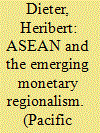

|
|
|
|
|
| Publication |
2008.
|
| Summary/Abstract |
Monetary regionalism - along with bilateral trade agreements - is receiving significant attention in Asia. This article analyzes its development since 2000 with specific reference to the role of ASEAN. It discusses the general rationale for monetary and financial cooperation, the Chiang Mai process, the rivalry between China and Japan, the potential exchange rate regime for the region including monitoring and surveillance, the evolution of regional bond markets, as well as the institutional dimension of monetary regionalism. The analysis confirms that monetary regionalism in Asia will be a complex endeavor and will - if at all - only be achieved in the long run. ASEAN will be able to function as a catalyst for monetary regionalism, but China and Japan are the more important players. Without their (joint) effort, ASEAN will not be able to achieve significant change in monetary and financial affairs.
|
|
|
|
|
|
|
|
|
|
|
|
|
|
|
|
| 2 |
ID:
102759
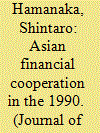

|
|
|
| 3 |
ID:
089515
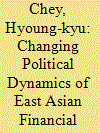

|
|
|
|
|
| Publication |
2009.
|
| Summary/Abstract |
This paper analyzes the factors that have contributed to the development of the Chiang Mai Initiative, one of the prominent examples of recent East Asian financial cooperation, by comparing it with the failed 1997 proposal for an Asian Monetary Fund
|
|
|
|
|
|
|
|
|
|
|
|
|
|
|
|
| 4 |
ID:
075471
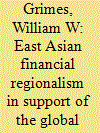

|
|
|
|
|
| Publication |
2006.
|
| Summary/Abstract |
East Asian financial regionalism has advanced significantly since the rejection of Japan 's Asian Monetary Fund proposal in 1997. Key ASEAN+3 initiatives include the Chiang Mai Initiative, which is designed to provide emergency liquidity to economies experiencing currency crisis, and the Asian Bond Market Initiative, which seeks to develop regional bond markets. Surprisingly, these initiatives-despite the assertive "regionalist" rhetoric that has surrounded them and their intellectual origins in the analysis of the 1997-1998 Asian financial crisis-are explicitly designed to complement existing features of the global financial architecture, including IMF conditionality and global financial standards. The nesting of East Asian financial regionalism within the global financial architecture results from the political-economic interests of the leading economies of the region. In the absence of a major change in the political-economic environment, nesting is a stable equilibrium and is unlikely to change.
|
|
|
|
|
|
|
|
|
|
|
|
|
|
|
|
| 5 |
ID:
121865
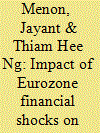

|
|
|
|
|
| Publication |
2013.
|
| Summary/Abstract |
Five years after the global financial crisis, the economies of the United States and the eurozone continue to struggle. How will Southeast Asian economies be affected should there be a further deterioration in conditions in the eurozone? In this paper, we present estimates using a Global Vector Autoregression (GVAR) model of the direct impacts of a further shock to the eurozone. We find that although the direct impacts are likely to be muted, it could trigger a much larger adjustment should it lead to a reassessment of risks and asset valuations. This is a real possibility given that vulnerability in the region has increased following massive inflows of capital and build-up of debt, related to successive bouts of quantitative easing in the United States initially, and now Japan. Should this happen, and with the IMF's resources already stretched, there is a pressing need to improve regional financial safety nets, which are currently unworkable, to deal with the fallout.
|
|
|
|
|
|
|
|
|
|
|
|
|
|
|
|
| 6 |
ID:
155095
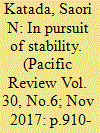

|
|
|
|
|
| Summary/Abstract |
Over the last 30 years, East Asia has progressed from virtually no intergovernmental arrangement in the 1980s to exclusive financial regionalism supported by strong centripetal forces in the aftermath of the Asian Financial Crisis (1997–1998), but this move has not yet produced coherent regional financial architecture. This article examines the evolution of Asia's regional financial architecture of the last three decades and discusses factors that have promoted and inhibited Asia's efforts toward financial regionalism. Since the Global Financial Crisis (2008–2009), the centripetal forces that aided the region's defensive regionalism have weakened, and the crisis has moved the region to seek multiple sources of financial stability from global to regional. On the one hand, given its export-promotion strategy, East Asia still relies heavily on the global financial architecture, and the region's US dollar dependence continues. On the other hand, the Global Financial Crisis has triggered China to seek reform in global financial order and some alternative solutions. For the latter, its monetary authority actively engages in internationalization of its currency, Renminbi, and promotion of the Asian Infrastructure Investment Bank. In this environment, coherent financial regionalism for East Asia is yet to emerge, as East Asian governments continue to search for monetary and financial stability.
|
|
|
|
|
|
|
|
|
|
|
|
|
|
|
|
| 7 |
ID:
143573
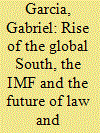

|
|
|
|
|
| Summary/Abstract |
Following the onset of the Asian Financial Crisis the world has witnessed a re-accommodation of the global financial system. In the particular case of middle-income countries they have disentangled themselves from the conditionality of the IMF and grown into more assertive actors in international forums, proposing new alternative mechanisms to become more financially independent and for the provision of development assistance. This article critically reviews the new reality by assessing the strategies deployed by developing countries to reduce the IMF’s influence, and explores the potential consequences of the rise of middle-income nations for Law and Development.
|
|
|
|
|
|
|
|
|
|
|
|
|
|
|
|
| 8 |
ID:
096598
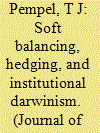

|
|
|
|
|
| Publication |
2010.
|
| Summary/Abstract |
East Asia has increased its formal institutional linkages in both the economic and security arenas. This article addresses three questions concerning this expansion. First, why has the number of institutions increased? Second, why is there so little overlap in the purposes and memberships of these many new bodies? Third, why have most regional institutions achieved such limited policy successes? The article demonstrates that the bulk of the new economic institutions represent collective responses to generalized pressures from globalized finance, whereas the new security bodies deal with regionally endogenous problems of a highly particularistic character. Furthermore, most regional bodies in East Asia still reflect the preeminence of individual state strategies rather than any collective predisposition toward multilateralism per se. East Asian regionalism thus represents a complex "ecosystem" of institutions whose future is likely to see the enhancement of some and the diminution of others through a process referred to here as "institutional Darwinism
|
|
|
|
|
|
|
|
|
|
|
|
|
|
|
|
|
|
|
|
|